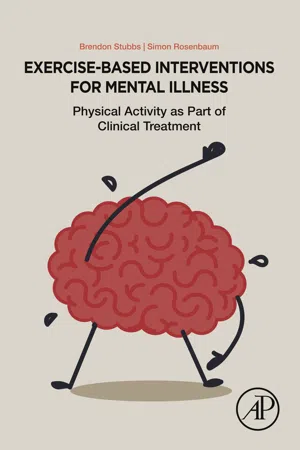
Exercise-Based Interventions for Mental Illness
Physical Activity as Part of Clinical Treatment
- 374 pages
- English
- ePUB (mobile friendly)
- Available on iOS & Android
Exercise-Based Interventions for Mental Illness
Physical Activity as Part of Clinical Treatment
About this book
Exercise-Based Interventions for People with Mental Illness: A Clinical Guide to Physical Activity as Part of Treatment provides clinicians with detailed, practical strategies for developing, implementing and evaluating physical activity-based interventions for people with mental illness. The book covers exercise strategies specifically tailored for common mental illnesses, such as depression, schizophrenia, bipolar disorder, and more. Each chapter presents an overview of the basic psychopathology of each illness, a justification and rationale for using a physical activity intervention, an overview of the evidence base, and clear and concise instructions on practical implementation.In addition, the book covers the use of mobile technology to increase physical activity in people with mental illness, discusses exercise programming for inpatients, and presents behavioral and psychological approaches to maximize exercise interventions. Final sections provide practical strategies to both implement and evaluate physical activity interventions.- Covers interventions for anxiety, depression, eating disorders, alcohol use disorder, and more- Provides the evidence base for exercise as an effective treatment for mental illness- Demonstrates how to use mobile technology to increase physical activity in people with mental illness- Features practical strategies for implementation and assessment- Covers treatment approaches for patients of all ages
Frequently asked questions
- Essential is ideal for learners and professionals who enjoy exploring a wide range of subjects. Access the Essential Library with 800,000+ trusted titles and best-sellers across business, personal growth, and the humanities. Includes unlimited reading time and Standard Read Aloud voice.
- Complete: Perfect for advanced learners and researchers needing full, unrestricted access. Unlock 1.4M+ books across hundreds of subjects, including academic and specialized titles. The Complete Plan also includes advanced features like Premium Read Aloud and Research Assistant.
Please note we cannot support devices running on iOS 13 and Android 7 or earlier. Learn more about using the app.
Information
Exercise for the Prevention and Treatment of Depression
Abstract
Keywords
Introduction
Relationship Between Physical Activity and Depression
Physical Activity and the Prevalence of Depression
Physical Activity and the Incidence of Depression
Table of contents
- Cover image
- Title page
- Table of Contents
- Notices
- Dedication
- List of Contributors
- Foreword
- Introduction
- Chapter 1. Exercise for the Prevention and Treatment of Depression
- Chapter 2. Exercise for the Management of Anxiety and Stress-Related Disorders
- Chapter 3. Bipolar Disorder and Physical Activity
- Chapter 4. Schizophrenia and Exercise
- Chapter 5. Exercise for Alcohol Use Disorders
- Chapter 6. Sedentary Behavior and Mental Health
- Chapter 7. Exercise for Older People With Mental Illness
- Chapter 8. Exercise for Adolescents and Young People With Mental Illness
- Chapter 9. Eating Disorders and Exercise—A Challenge
- Chapter 10. Behavioral and Psychological Approaches in Exercise-Based Interventions in Severe Mental Illness
- Chapter 11. Exercise Interventions in Secure and Forensic Services
- Chapter 12. mHealth and Physical Activity Interventions Among People With Mental Illness
- Chapter 13. Integration of the Exercise Professional Within the Mental Health Multidisciplinary Team
- Chapter 14. Integrating Physical Activity Into Routine Medical Care: The Physician's Perspective
- Chapter 15. Overview of Mechanisms of Action of Exercise in Psychiatric Disorders and Future Directions for Research
- Chapter 16. Research and Evaluation in Exercise and Mental Health
- Chapter 17. Research to Practice: Case Studies
- Index